1962 Centennial of J.E.B. Stuart's Raid of Chambersburg
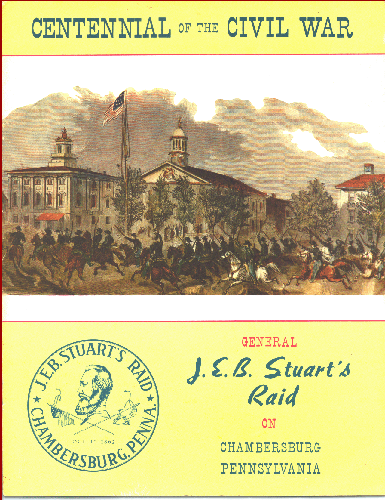 |
Chambersburg's Civil War Centennial Committee chose a crossed Union-and-Confederate-flags/J.E.B.-Stuart-profile logo to promote the 100th year commemoration of Confederate cavalry general Stuart's raid on Chambersburg in October 1862. The observance of 1962 culminated in a one or two-day event whose features echoed the logo by incorporating North-South reconciliation gestures.
The committee invited reenactors from Southern states and portraying Confederate soldiers to join their Northern counterparts in a "colorful" portrayal of Stuart's raid, which was followed by a "Blue-Gray Military Ball" in honor of the visiting reenactors from all states. On the same day or another, "The Blue-Gray Minstrels" performed Southern as well as Northern songs from the Civil War period.1
Yet the committee balanced the reconciliationist tone of the event with a harsher historical perspective in a booklet it issued as an accompanying souvenir: General J.E.B. Stuart's Raid on Chambersburg Pennsylvania. Although Stuart's men had destroyed only military and railroad facilities in Chambersburg, the booklet noted that, as the fires they set burned "only a short distance from the thickly populated section of the town the conflagration caused great alarm." The booklet also speculated that Stuart's raid was notable more "for arousing bitterness and crushing pride" than accomplishing "any military objective."2
|
Souvenir booklet issued for Chambersburg's Stuart-Raid Centennial, 1962. Courtesy of Greater Chambersburg Chamber of Commerce.
|
|
On the inside of the General J.E.B. Stuart's Raid booklet, the Centennial Committee gave a statement of purpose for the commemoration:
1963 Centennial of the Occupation of Waynesboro
Waynesboro, Pennsylvania's Civil War Commission chose a clasped-Union-and-Confederate-hands/crossed-Union-and-Confederate-flags logo, supplemented by tiny portraits of Jefferson Davis, Robert E. Lee, Abraham Lincoln, and Ulysses Grant, to promote the 100th-year commemoration of Waynesboro's occupation by Confederates. The observance of 1963 culminated in a two-day event that featured a fireworks display, a battle reenactment, a reenactment of the town's occupation, and a "Beard and Moustache Contest."3
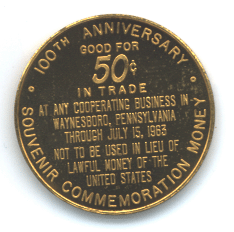 |
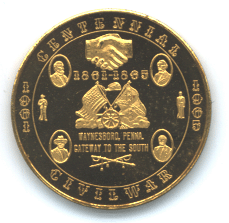 |
Souvenir token issued in 1963 for Waynesboro, Pennsylvania's Confederate-occupation centennial
|
Note the clasped-hands motif atop the token's other symbols.
|
The clasped-hands, crossed-flags, and Confederate portrait motifs reflected the strongly reconciliationist tone of the centennial in Waynesboro--an emphasis on North-South harmony that surpassed even that of the previous year's commemoration of Stuart's raid on Chambersburg. The Waynesboro commission's reconciliationist sentiment found embodiment in Fifteen Days Under the Confederate Flag, a souvenir booklet that it issued to accompany the occupation-observance and that featured the clasped-hands/crossed-flags logo prominently on the back cover.4
Characterizing the conflict of 1861-1865 as a "war between brothers," the booklet's foreword called "attention to the great struggle from which our nation emerged united." The text that followed acknowledged local feelings, prior to and after the Confederate occupation, "of intense antagonism toward the Southern soldier," due to his willingness to kill Northerners in uniform. Yet the booklet asserted that the view of a typical Waynesboro area-civilian--a Northerner out of uniform, in other words--in the wake of "noticing the courtesy and politeness of the southern visitors\205often changed to that of respect and in a certain degree to that of politeness" during the occupation of 1863.5
1964 Centennial of the Burning of Chambersburg
Waynesboro residents had experienced nothing near the Civil War trauma of Chambersburg's massive conflagration of 1864, a Confederate-set blaze that had overshadowed the comparatively tiny fire set by J.E.B. Stuart's Confederate raiders there in 1862. A century later, Chambersburg residents formed a Bicentennial-Centennial Corporation to direct both the 100th-year commemoration of the burning and the 200th-year commemoration of the town's founding--observances occurring simultaneously in 1964. For the burning-commemoration logo, the corporation adopted an image of Confederate troops setting the Franklin County courthouse ablaze.6
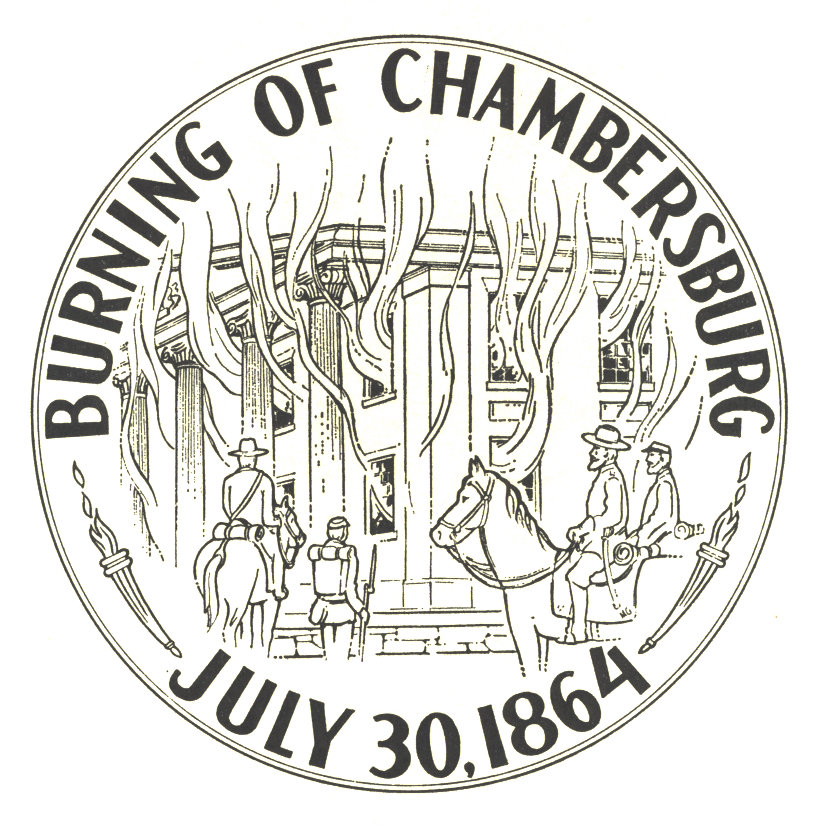 |
|
|
Logo for Chambersburg's Confederate-burning centennial. Courtesy of Greater Chambersburg Chamber of Commerce.
|
Both sides of a souvenir token issued for Chambersburg's Confederate-burning centennial, 1964.
|
The observations produced at least one souvenir token and a souvenir booklet, "From This Valley": Crossroads of Destiny, Chambersburg, Pennsylvania Bicentennial-Centennial. Both carried the Confederate-burning logo prominently.
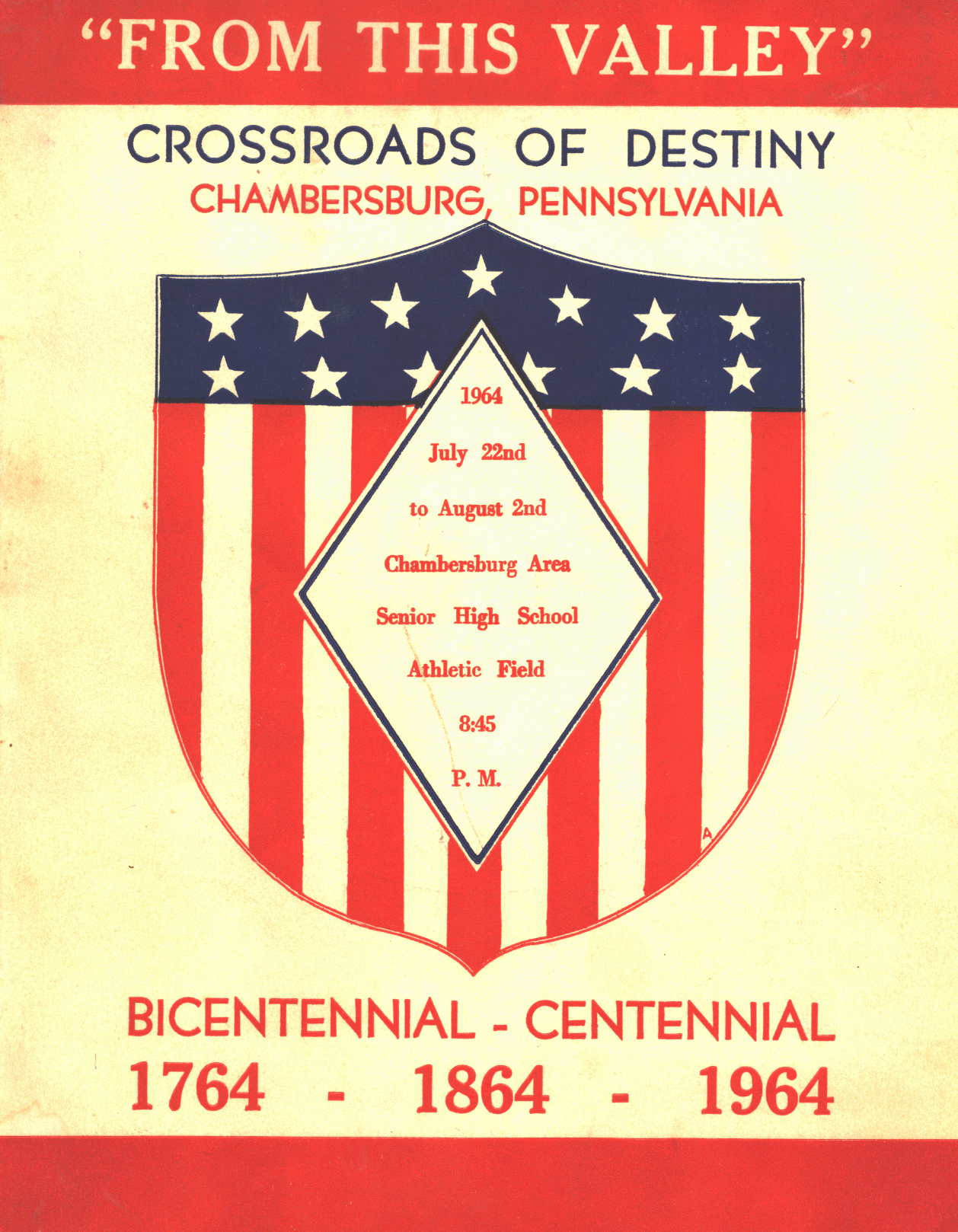 |
Those sections of From This Valley devoted to the fire of 1864 followed the harsh symbolism of the burning-logo by offering little of the reconciliationist sentiment that was present in the Chambersburg Stuart's-raid centennial booklet and prominent in the Waynesboro Confederate-occupation centennial booklet. From This Valley asserted that the Southern troops who set Chambersburg ablaze gave "[n]o consideration\205to the sick or infirm" among the townspeople. Confederates seeking to fuel the conflagration moved non-combustibles to streets and yards, "making haste more difficult" for the fleeing residents.7
Overall, however, Chambersburg's bicentennial-centennial planners muted this sectional antagonism. They commemorated the burning and other Civil War events in only one of 17 historical pageants. Those featured local residents, who starred in six days of performances that portrayed characters from local history in chronological episodes, ranging from European-Native American contact ("Land of the Redman") through World War II ("For One Cause--Freedom").8
|
Souvenir booklet issued for Chambersburg's Burning-Centennial and Founding- Bicentennial, 1964. Courtesy of Greater Chambersburg Chamber of Commerce.
|
|
From This Valley, moreover, carried advertisements from its sponsors that offered various historical messages on the burning of 1864:
|
|
Courtesy of Greater Chambersburg Chamber of Commerce.
|
Franklin County Centennial Calendars
Throughout and in the immediate aftermath of the centennial years of the 1960's, a Chambersburg business issued calendars commemorating Civil War events.
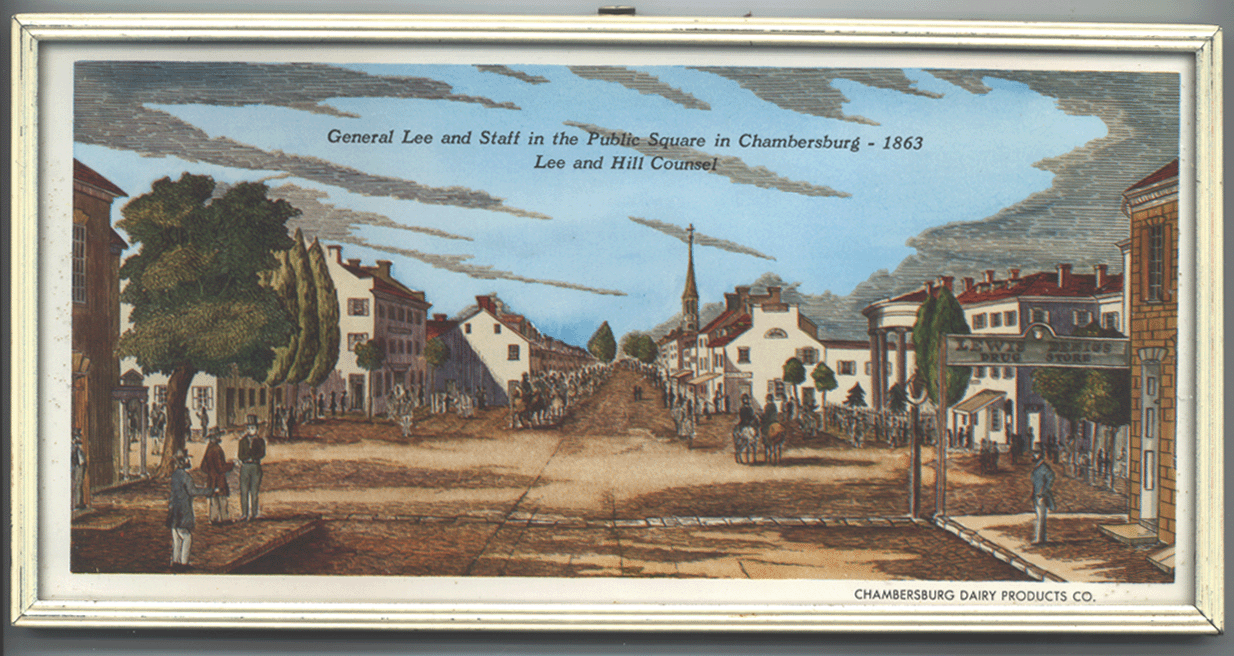 |
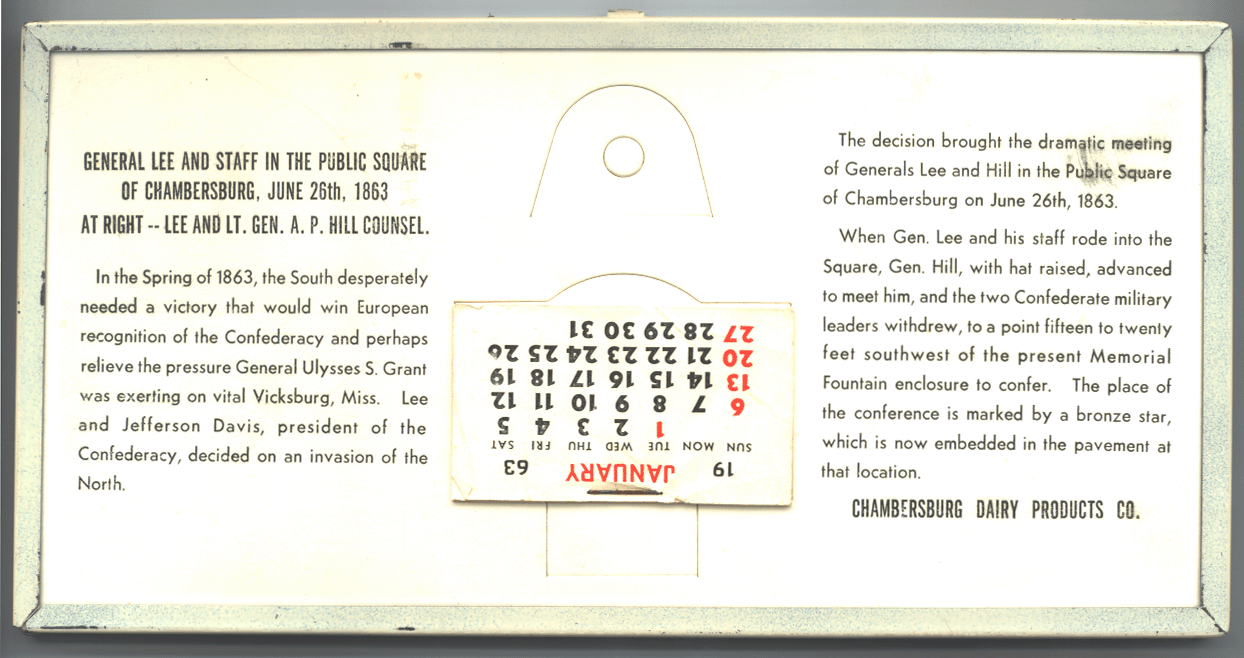 |
Both sides of the calendar for 1963. The scene is a colorized adaptation of a woodcut published in the 1840's.
|
Courtesy of Harrisburg Dairies, Inc.
|
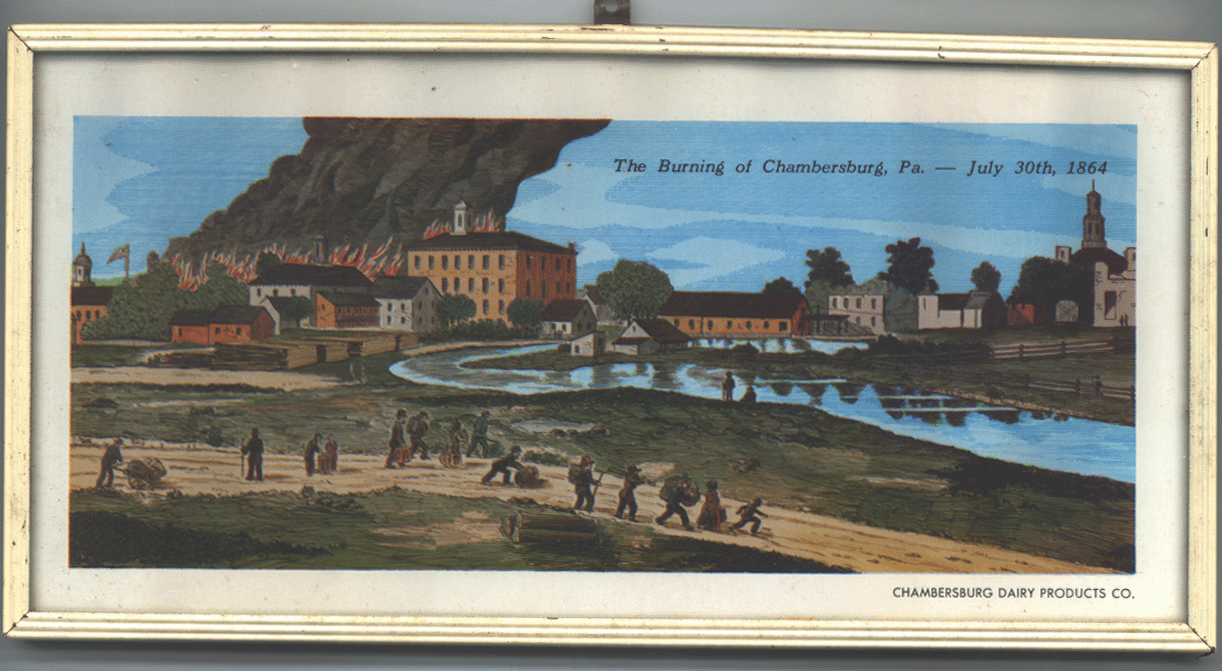 |
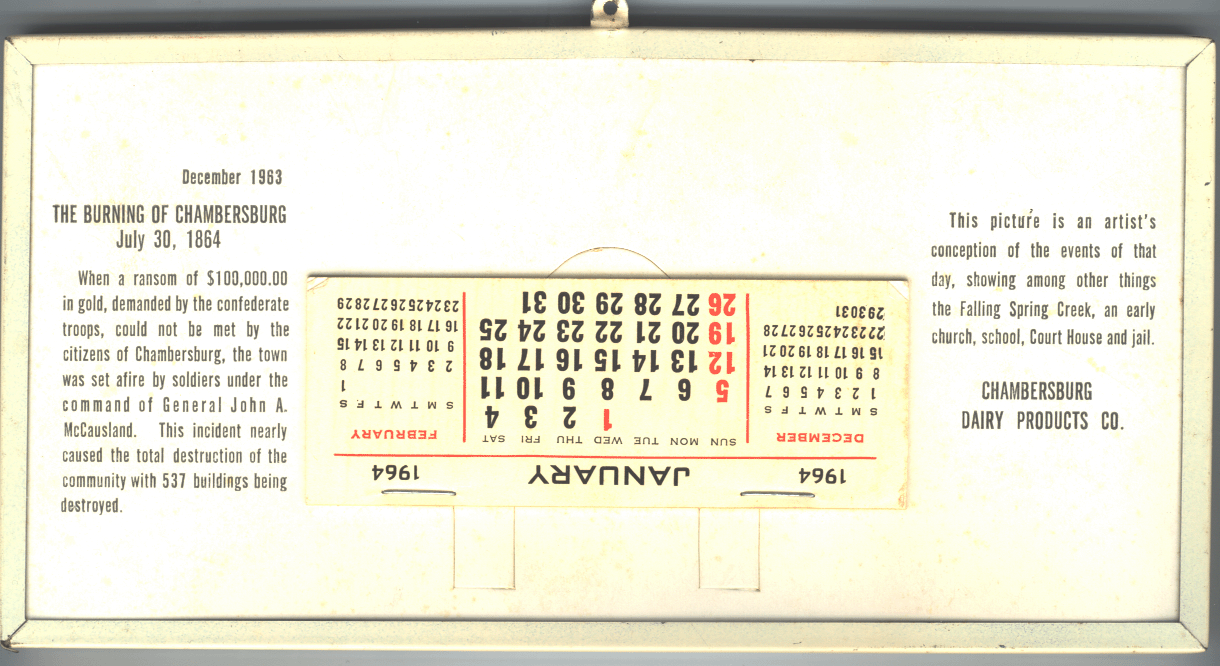 |
Both sides of the calendar for 1964.
|
Courtesy of Harrisburg Dairies, Inc.
|
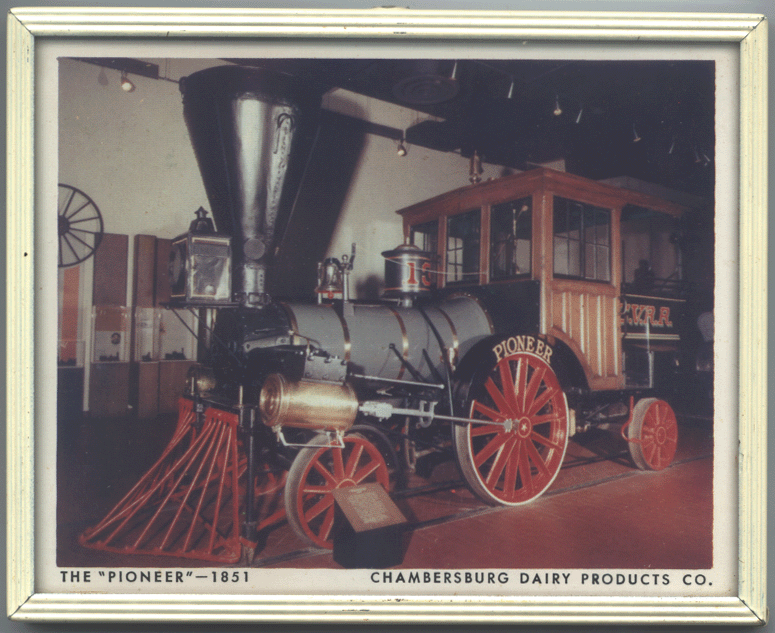 |
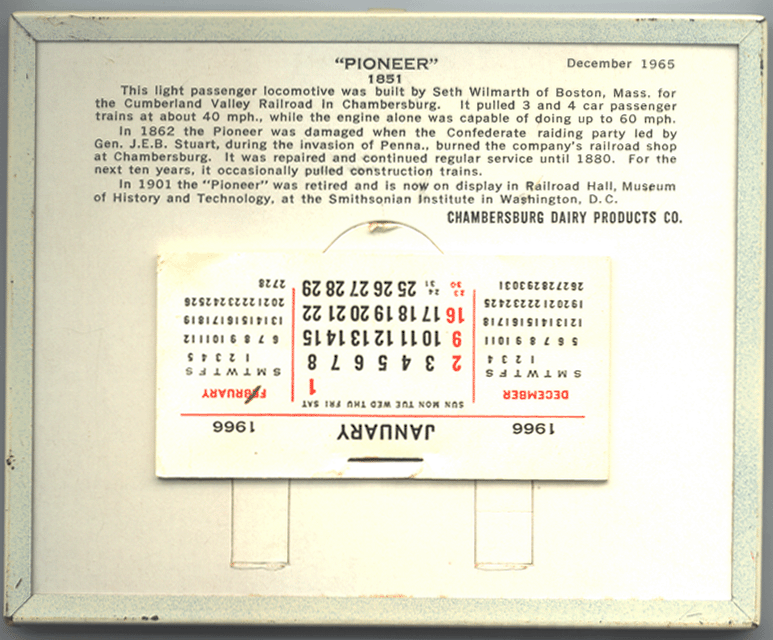 |
Both sides of the calendar for 1966.
|
Courtesy of Harrisburg Dairies, Inc.
|
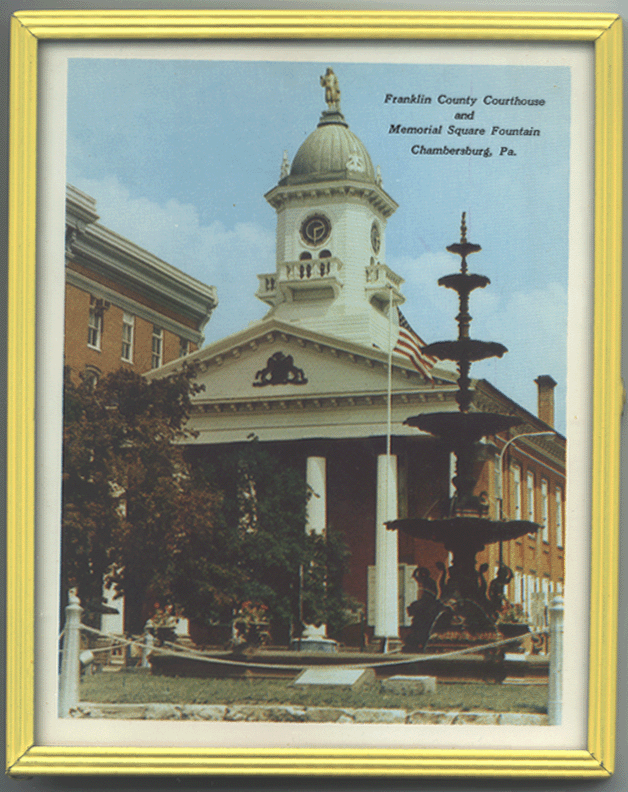 |
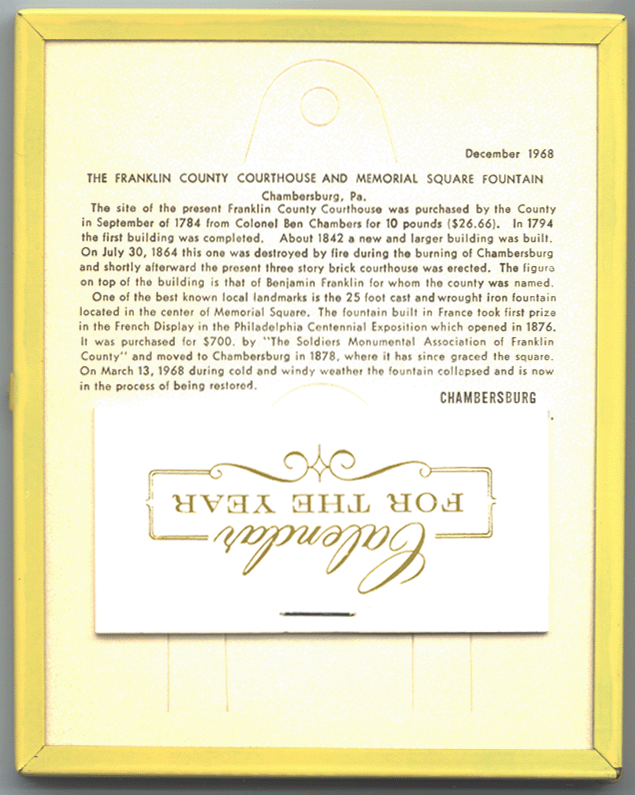 |
Both sides of the calendar for 1969. Note the continued presence but reduced prominence of Civil War history in the calendars' captions after 1965, the last centennial year.
|
Courtesy of Harrisburg Dairies, Inc.
|
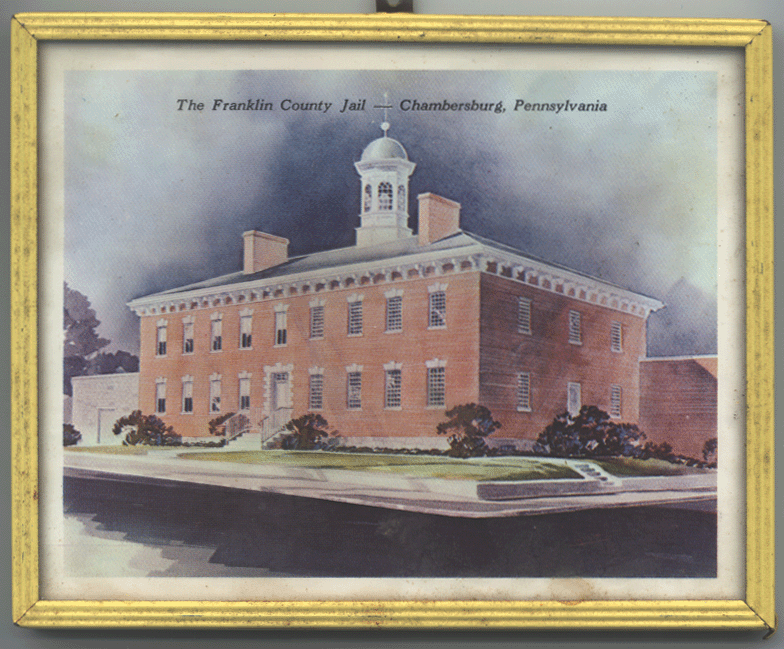 |
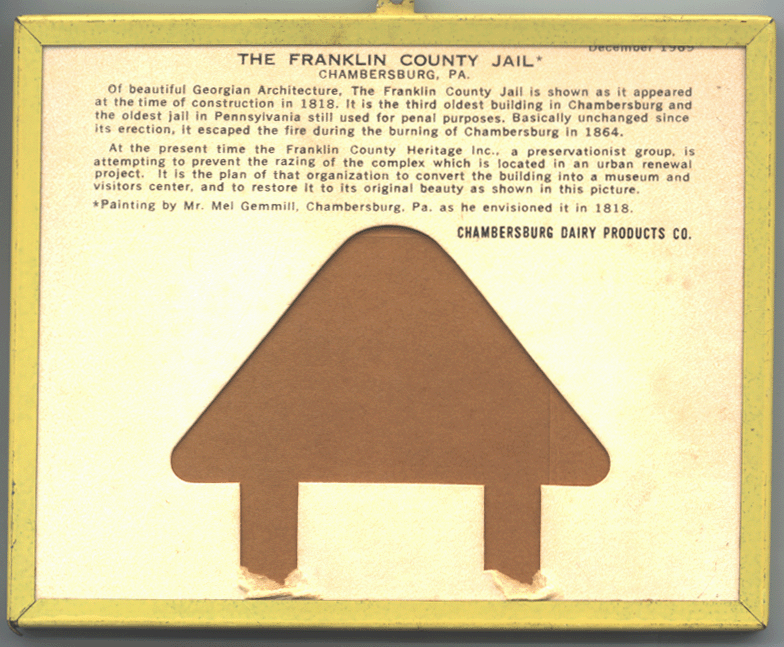 |
Both sides of the calendar for 1970. Note the implication, in the caption's text, that Urban Renewal (a federal program of the 1940's-1970's that encouraged and helped underwrite the demolition of vast numbers of buildings considered as "blight" by some planners) was as harmful to Chambersburg as the Confederate burning of 1864.
|
Courtesy of Harrisburg Dairies, Inc.
|
Notes:
1Civil War Centennial Committee of Greater Chambersburg Chamber of Commerce, General J.E.B. Stuart's Raid on Chambersburg Pennsylvania (Chambersburg: Greater Chambersburg Chamber of Commerce, 1962), not paginated (quotations).
2Ibid. (quotations).
3Civil War Commission of Greater Waynesboro Chamber of Commerce, Fifteen Days Under the Confederate Flag (Waynesboro, Pa.: Greater Waynesboro Chamber of Commerce, 1963), n. p. (quotations).
4Ibid.
5Ibid. (quotations).
6Commemorative Program Committee of Greater Chambersburg Chamber of Commerce, "From This Valley": Crossroads of Destiny, Chambersburg, Pennsylvania Bicentennial-Centennial (Chambersburg: Greater Chambersburg Chamber of Commerce, 1964), pp. 53, rear endsheet. The role of the committee, not to be confused with the corporation, in writing and/or publishing the booklet is documented in Ibid., p. 104, "Cover" note on flyleaf.
7Ibid., p. 59 (quotations).
8Ibid., pp. 54 (first quotation), 55 (second quotation). |
|


